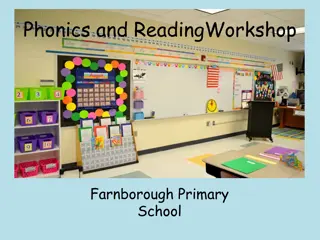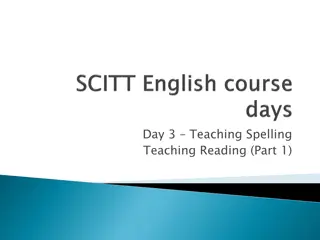Understanding Phonics: A Guide for Parents
This resource provides information for parents on what their child learns during a phonics lesson, including lesson focus, GPCS words, tricky words, oral blending, new words, and expectations. It also covers how to read with children and support their reading at home through decoding, prosody, and comprehension. Helpful tips and examples are included to enhance parent-child learning collaboration.
Download Presentation

Please find below an Image/Link to download the presentation.
The content on the website is provided AS IS for your information and personal use only. It may not be sold, licensed, or shared on other websites without obtaining consent from the author. Download presentation by click this link. If you encounter any issues during the download, it is possible that the publisher has removed the file from their server.
E N D
Presentation Transcript
Phonics Information for Parents Thursday 20thOctober 2022
This afternoon we hope to cover the following What does my child learning during a phonics lesson? What are the expectations of my child? How do we read with children in school and how can you continue to support your child reading at home.
What does my child learn during a phonics lesson? Lesson Focus Revisit and Review Pronunciation Initial/End sounds What s in the box? New sound and mnemonic Formation Oral Blending Teacher led Blending Independent Blending Tricky Words Oral Blending Game ck sock a p i n m d g o c k Open your mouth into a little smile; make your tongue flat and move it up towards the top of your mouth to say c c c neck lock tick sock ck sock For c: Curl round the heel of the sock. For k: Down the sock, up and across, back and down to the corner. Catchphrase: ck Rock that sock! Review: c-a-t k-i-t d-o-g New: s-o-ck p- i-ck p-a-ck kit dog cat nod sock Independent: dig pat New: I Review: is Can you touch your ... ? l-e-g ch-ee-k b-a-ck h-ee-
Lesson Focus GPCS Words Tricky Words Oral Blending New Words Examples definition and sentences Read / Write Sentence s Spelling CVCC CCVC and CCVCC ai ee igh oa ear air er sh ch qu frog frost drum flag hand milk was they s-n-a-ck sh-r- i-nk s-qu-e-l- ch snack shelf shrink squelch stand slep shrink Become smaller Grapes shrink when they are dried out and become raisins. squelch A noise you make when you re walking through something thick and sticky, like mud We squelch through the mud in our wellies! slept Past tense of sleep We slept in tents in the garden The frog slept in the drum frog drum + the
What are the expectations of my child? See handout
How do we read with the children and how can you continue to support your child reading at home? Decoding: Before we read the book we practise GPCs sounds e.g. ar, ee, words and tricky words discussing the meaning of words e.g. dash. Encourage children to read automatically/fluently (sounding in head if needed). Prosody: We read the book (aiming for 95% fluency) with expression we model reading with expression. Comprehension: When we have read the book we answer questions about the book.
Although your child will be taught to read at school, you can have a huge impact on their reading journey by continuing their practice at home. There are two types of reading book that your child will bring home: A reading practise book. This will be at the correct phonic stage for your child. Your child will start to bring these home when they can sound and blend. They should be able to read this fluently and independently. A sharing book. Your child will not be able to read this on their own. This book is for you both to read and enjoy together.
Reading Book: The reading book has been carefully matched to your child s current reading level. If your child is reading it with little help, please don t worry that it s too easy your child needs to develop fluency and confidence in reading. Listen to them read the book. Remember to give them lots of praise celebrate their success! If they can t read a word, read it to them. After they have finished, talk about the book together. Sharing Book: In order to encourage your child to become a lifelong reader, it is important that they learn to read for pleasure. The sharing book is a book they have chosen for you to enjoy together. Please remember that you shouldn t expect your child to read this alone. Read it to or with them. Discuss the pictures, enjoy the story, predict what might happen next, use different voices for the characters, explore the facts in a non-fiction book. The main thing is that you have fun!
Please visit the following webpage to find out more https://www.littlewandlelettersandsounds.org.uk/resources/for- parents/























